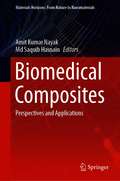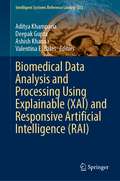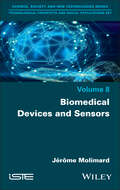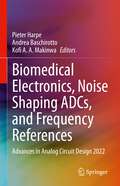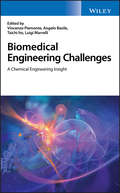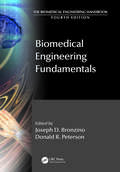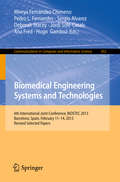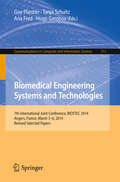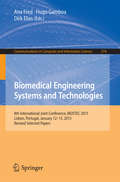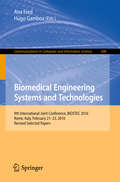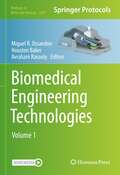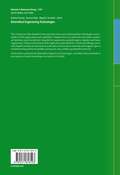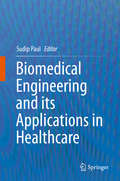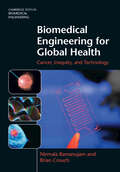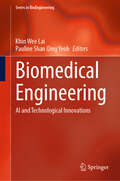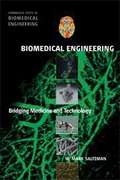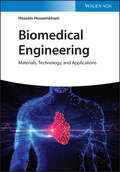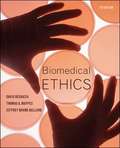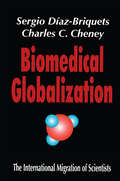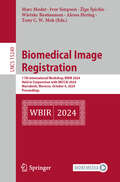- Table View
- List View
Biomedical Composites: Perspectives and Applications (Materials Horizons: From Nature to Nanomaterials)
by Amit Kumar Nayak Md Saquib HasnainThis book provides an overview of biocomposite chemistry, chemical modifications, characterization and applications in biomedicine, with emphasis on recent advances in the field. Authored by experts, the chapters discuss the design, development and selection of biomedical composites for a particular therapeutic application, as well as providing insight into the regulatory and clinical aspects of biomedical composite use. While this book is primarily intended for scientists from the fields of medical, pharmaceutical, biotechnological and biomedical engineering, it is also useful as an advanced text for students and research scholars.
Biomedical Data Analysis and Processing Using Explainable (Intelligent Systems Reference Library #222)
by Valentina E. Balas Deepak Gupta Ashish Khanna Aditya KhampariaThe book discusses Explainable (XAI) and Responsive Artificial Intelligence (RAI) for biomedical and healthcare applications. It will discuss the advantages in dealing with big and complex data by using explainable AI concepts in the field of biomedical sciences. The book explains both positive as well as negative findings obtained by explainable AI techniques. It features real time experiences by physicians and medical staff for applied deep learning based solutions. The book will be extremely useful for researchers and practitioners in advancing their studies.
Biomedical Devices and Sensors
by Jérôme MolimardMonitoring the human body is a key element of digital health science. Low-cost sensors derived from smartphones or smartwatches may give the impression that sensors are readily available; however, to date, very few of them are actually medical devices. Designing medical devices requires us to undertake a specific approach demanding special skills, as it concerns the integrity of the human body. The process is tightly framed by state regulations in order to ensure compliance with quality assessment, risk management and medical ethics requirements. This book aims to give biomedical students an overview on medical devices design. It firstly gives a historical and economical approach, then develops key elements in medical device design with reference to EU and US regulations, and finally describes sensors for the human body. The clinical approach is presented as the central element in medical device qualification and this offers a perspective on the use of numerical simulation, particularly since its continued growth in the USA; despite the fact that the approach is strictly limited by regulations.
Biomedical Devices: Design, Prototyping, and Manufacturing
by Paolo Jorge Bártolo Elisabetta Ceretti Jorge Vicente Da Silva Tŭgrul Özel Ciro Angel Rodriguez Joaquim De GayBiomedical Devices: Design, Prototyping, and Manufacturing features fundamental discussions of all facets of materials processing and manufacturing processes across a wide range of medical devices and artificial tissues. Represents the first compilation of information on the design, prototyping, and manufacture of medical devices into one volume Offers in-depth coverage of medical devices, beginning with an introductory overview through to the design, manufacture, and applications Features examples of a variety of medical applications of devices, including biopsy micro forceps, micro-needle arrays, wrist implants, spinal spacers, and fixtures Provides students, doctors, scientists, and technicians interested in the development and applications of medical devices the ideal reference source
Biomedical Electronics, Noise Shaping ADCs, and Frequency References: Advances in Analog Circuit Design 2022
by Kofi A. A. Makinwa Andrea Baschirotto Pieter HarpeThis book is based on the 18 tutorials presented during the 30th workshop on Advances in Analog Circuit Design. Expert designers present readers with information about a variety of topics at the frontier of analog circuit design, with specific contributions focusing on analog circuits for machine learning, current/voltage/temperature sensors, and high-speed communication via wireless, wireline, or optical links. This book serves as a valuable reference to the state-of-the-art, for anyone involved in analog circuit research and development.
Biomedical Engineering Challenges: A Chemical Engineering Insight
by Luigi Marrelli Angelo Basile Vincenzo Piemonte Taichi ItoAn important resource that puts the focus on the chemical engineering aspects of biomedical engineering In the past 50 years remarkable achievements have been advanced in the fields of biomedical and chemical engineering. With contributions from leading chemical engineers, Biomedical Engineering Challenges reviews the recent research and discovery that sits at the interface of engineering and biology. The authors explore the principles and practices that are applied to the ever-expanding array of such new areas as gene-therapy delivery, biosensor design, and the development of improved therapeutic compounds, imaging agents, and drug delivery vehicles. Filled with illustrative case studies, this important resource examines such important work as methods of growing human cells and tissues outside the body in order to repair or replace damaged tissues. In addition, the text covers a range of topics including the challenges faced with developing artificial lungs, kidneys, and livers; advances in 3D cell culture systems; and chemical reaction methodologies for biomedical imagining analysis. This vital resource: Covers interdisciplinary research at the interface between chemical engineering, biology, and chemistry Provides a series of valuable case studies describing current themes in biomedical engineering Explores chemical engineering principles such as mass transfer, bioreactor technologies as applied to problems such as cell culture, tissue engineering, and biomedical imaging Written from the point of view of chemical engineers, this authoritative guide offers a broad-ranging but concise overview of research at the interface of chemical engineering and biology.
Biomedical Engineering Fundamentals (The Biomedical Engineering Handbook, Fourth Edition)
by Joseph D. Bronzino Donald R. PetersonKnown as the bible of biomedical engineering, The Biomedical Engineering Handbook, Fourth Edition, sets the standard against which all other references of this nature are measured. As such, it has served as a major resource for both skilled professionals and novices to biomedical engineering.Biomedical Engineering Fundamentals, the first volume of
Biomedical Engineering Principles
by Arthur B. Ritter Vikki Hazelwood Antonio Valdevit Alfred N. AscioneCurrent demand in biomedical sciences emphasizes the understanding of basic mechanisms and problem solving rather than rigid empiricism and factual recall. Knowledge of the basic laws of mass and momentum transport as well as model development and validation, biomedical signal processing, biomechanics, and capstone design have indispensable roles i
Biomedical Engineering Systems and Technologies: 6th International Joint Conference, BIOSTEC 2013, Barcelona, Spain, February 11-14, 2013, Revised Selected Papers (Communications in Computer and Information Science #452)
by Jordi Solé-Casals Ana Fred Mireya Fernández-Chimeno Pedro L. Fernandes Sergio Alvarez Deborah Stacey Hugo GamboaThis book constitutes the thoroughly refereed post-conference proceedings of the 6th International Joint Conference on Biomedical Engineering Systems and Technologies, BIOSTEC 2013, held in Barcelona, Spain, in February 2013. The 28 revised full papers presented were carefully reviewed and selected from a total of 392 submissions. The papers cover a wide range of topics and are organized in four general topical sections on biomedical electronics and devices; bioinformatics models, methods and algorithms; bio-inspired systems and signal processing; health informatics.
Biomedical Engineering Systems and Technologies: 7th International Joint Conference, BIOSTEC 2014, Angers, France, March 3-6, 2014, Revised Selected Papers (Communications in Computer and Information Science #511)
by Ana Fred Hugo Gamboa Guy Plantier Tanja SchultzThis book constitutes the thoroughly refereed post-conference proceedings of the 7th International Joint Conference on Biomedical Engineering Systems and Technologies, BIOSTEC 2014, held in Angers, France, in March 2014. The 25 revised full papers presented were carefully reviewed and selected from a total of 362 submissions. The papers cover a wide range of topics and are organized in topical sections on biomedical electronics and devices; bioimaging; bioinformatics models, methods and algorithms; bio-inspired systems and signal processing; health informatics.
Biomedical Engineering Systems and Technologies: 8th International Joint Conference, BIOSTEC 2015, Lisbon, Portugal, January 12-15, 2015, Revised Selected Papers (Communications in Computer and Information Science #574)
by Ana Fred Hugo Gamboa Dirk EliasThis book constitutes the thoroughly refereedpost-conference proceedings of the 8th International Joint Conference onBiomedical Engineering Systems and Technologies, BIOSTEC 2015, held in Lisbon,Portugal, in January 2015. The 27 revised full papers presented together with aninvited paper were carefully reviewed and selected from a total of 375submissions. The papers cover a wide range of topics and are organized in fourgeneral topical sections on biomedical electronics and devices;bioimaging; bioinformatics models,methods and algorithms; bio-inspired systems and signalprocessing; health informatics.
Biomedical Engineering Systems and Technologies: 9th International Joint Conference, BIOSTEC 2016, Rome, Italy, February 21–23, 2016, Revised Selected Papers (Communications in Computer and Information Science #690)
by Ana Fred Hugo GamboaThis book contains the best papers of the First International Joint Conference on B- medical Engineering Systems and Technologies (BIOSTEC 2008), organized by the Institute for Systems and Technologies of Information Control and Communication (INSTICC), technically co-sponsored by the IEEE Engineering in Medicine and Bi- ogy Society (EMB), ACM SIGART and the Workflow Management Coalition (WfMC), in cooperation with AAAI. The purpose of the International Joint Conference on Biomedical Engineering S- tems and Technologies is to bring together researchers and practitioners, including engineers, biologists, health professionals and informatics/computer scientists, int- ested in both theoretical advances and applications of information systems, artificial intelligence, signal processing, electronics and other engineering tools in knowledge areas related to biology and medicine. BIOSTEC is composed of three co-located conferences; each specializes in one of the aforementioned main knowledge areas, namely: * BIODEVICES (International Conference on Biomedical Electronics and - vices) focuses on aspects related to electronics and mechanical engineering, - pecially equipment and materials inspired from biological systems and/or - dressing biological requirements. Monitoring devices, instrumentation sensors and systems, biorobotics, micro-nanotechnologies and biomaterials are some of the technologies addressed at this conference.
Biomedical Engineering Technologies: Volume 1 (Methods in Molecular Biology #2393)
by Avraham Rasooly Houston Baker Miguel R. OssandonThis volume provides detailed technical protocols on current biosensors and imaging technologies and Chapters focus on optical, electrochemical, Quartz crystal microbalance (QCM) biosensors and on medical imaging technologies such as tomography, MRI, and NMR. Written in the format of the highly successful Methods in Molecular Biology series, each chapter includes an introduction to the topic, lists necessary materials and reagents, includes tips on troubleshooting and known pitfalls, and step-by-step, readily reproducible protocols. Authoritative and practical, Biomedical Engineering Technologies, Volume 1 provides technical details in descriptions of major technologies by experts in the field.
Biomedical Engineering Technologies: Volume 2 (Methods in Molecular Biology #2394)
by Avraham Rasooly Houston Baker Miguel R. OssandonThis volume provides detailed technical protocols on current biomedical technologies and examples of their applications and capabilities. Chapters focus on molecular and cellular analytical methods, experimental new drug delivery approaches, guided surgery, implants and tissue engineering. Written in the format of the highly successful Methods in Molecular Biology series, each chapter includes an introduction to the topic, lists necessary materials and reagents, tips on troubleshooting and known pitfalls, and step-by-step, readily reproducible protocols. Authoritative and practical, Biomedical Engineering Technologies, Volume 2 provides technical details in descriptions of major technologies by experts in the field.
Biomedical Engineering and Environmental Engineering: Proceedings of the 2014 2nd International Conference on Biomedical Engineering and Environmental Engineering (ICBEEE 2014), December 24-25, 2014, Wuhan, China
by David ChanThis conference series is a forum for enhancing mutual understanding between Biomedical Engineering and Environmental Engineering field. This proceeding provides contributions from many experts representing industry and academic establishments worldwide. The researchers are from different countries and professional. The conference brought 
Biomedical Engineering and its Applications in Healthcare
by Sudip PaulThis book illustrates the significance of biomedical engineering in modern healthcare systems. Biomedical engineering plays an important role in a range of areas, from diagnosis and analysis to treatment and recovery and has entered the public consciousness through the proliferation of implantable medical devices, such as pacemakers and artificial hips, as well as the more futuristic technologies such as stem cell engineering and 3-D printing of biological organs. Starting with an introduction to biomedical engineering, the book then discusses various tools and techniques for medical diagnostics and treatment and recent advances. It also provides comprehensive and integrated information on rehabilitation engineering, including the design of artificial body parts, and the underlying principles, and standards. It also presents a conceptual framework to clarify the relationship between ethical policies in medical practice and philosophical moral reasoning. Lastly, the book highlights a number of challenges associated with modern healthcare technologies.
Biomedical Engineering for Global Health
by Rebecca Richards-KortumCan technology and innovation transform world health? Connecting undergraduate students with global problems, Rebecca Richard-Kortum examines the interplay between biomedical technology design and the medical, regulatory, economic, social and ethical issues surrounding global health. Driven by case studies, including cancer screening, imaging technologies, implantable devices and vaccines, students learn how the complexities and variation across the globe affect the design of devices and therapies. A wealth of learning features, including classroom activities, project assignments, homework problems and weblinks within the book and online, provide a full teaching package. For visionary general science and biomedical engineering courses, this book will inspire students to engage in solving global issues that face us all.
Biomedical Engineering for Global Health: Cancer, Inequity, and Technology (Cambridge Texts in Biomedical Engineering)
by Nirmala Ramanujam Brian CrouchExplore the fundamentals of biomedical engineering technologies with this thought-provoking introduction, framed around modern-day global cancer inequities. Connecting engineering principles to real-world global health scenarios, this textbook introduces major technological advances in cancer care through the lens of global health inequity, discusses how promising new technologies can address this inequity, and demonstrates how novel medical technologies are adopted for real-world clinical use. It includes modular chapters designed to enable a flexible pathway through material, for students from a wide range of backgrounds; boxed discussion of contemporary issues in engineering for global health, encouraging students to explore ethical questions related to science and society; supplementary lab modules for hands-on experience in translating engineering principles into healthcare solutions; and over 200 end-of-chapter problems, targeting multiple learning outcomes to solidify student understanding. This introduction is designed to equip students with all the critical, technical, and ethical knowledge they need to excel.
Biomedical Engineering: AI and Technological Innovations (Series in BioEngineering)
by Khin Wee Lai Pauline Shan Qing YeohThis book brings together contributions from leading experts in the field, each addressing a critical area where AI and technology are making significant impacts. The chapters encompass a wide range of topics, from the application of machine learning in cancer grading and maternal health monitoring to the development of innovative wearable devices and advanced diagnostic tools. The book not only underscores the transformative potential of AI and technology in biomedical; but also serves as a vital resource for researchers, practitioners, and students. By showcasing the latest research and innovations, this book aims to inspire continued exploration and development in this dynamic and rapidly evolving field.
Biomedical Engineering: Bridging Medicine and Technology
by W. Mark SaltzmanThis book is an introduction to biomedical engineering, starting from the basics and demonstrating the engineering principles that are used to create new diagnostic methods and therapies for human disease. Although biomedical engineering is a relatively new field of study, it will impact almost every person in the world.
Biomedical Engineering: Materials, Technology, and Applications
by Hossein HosseinkhaniBiomedical Engineering An exploration of materials processing and engineering technology across a wide range of medical applications The field of biomedical engineering has played a vital role in the progression of medical development technology. Biomedical Engineering: Materials, Technology, and Applications covers key aspects of the field—from basic concepts to advanced level research for medical applications. The book stands as a source of inspiration for research on materials as well as their development and practical application within specialized industries. It begins with a discussion of what biomedical engineering is and concludes with a final chapter on the advancements of biomaterials technology in medicine. Offers comprehensive coverage of topics, including biomaterials, tissue engineering, bioreceptor interactions, and various medical applications Discusses applications in critical industries such as biomedical diagnosis, pharmaceutics, drug delivery, cancer detection, and more Serves as a reference for those in scientific, medical, and academic fields Biomedical Engineering takes an interdisciplinary look at how biomedical science and engineering technology are integral to developing novel approaches to major problems, such as those associated with disease diagnosis and drug delivery. By covering a full range of materials processing and technology-related subjects, it shares timely information for biotechnologists, material scientists, biophysicists, chemists, bioengineers, nanotechnologists, and medical researchers.
Biomedical Ethics (Seventh Edition)
by David Degrazia Thomas Mappes Jeffrey BallardThis best-selling anthology of readings with case studies provides insightful and comprehensive treatment of ethical issues in medicine. Appropriate for courses taught in philosophy departments, bioethics programs, as well as schools of medicine and nursing, the collection covers such provocative topics as biomedical enhancement, clinical trials in developing countries, animal research, physician-assisted suicide, and health care reform. The text's effective pedagogical features include chapter introductions, argument sketches, explanations of medical terms, headnotes, and annotated bibliographies.
Biomedical Globalization: The International Migration of Scientists
by Charles CheneyDespite much debate in recent years about the economic and professional impact of foreign engineers and computer professionals in the United States, comparatively little has been said about the growing number of foreign biomedical scientists employed by American firms and health institutions. The implications are widespread and merit serious analysis. In Biomedical Globalization, Sergio Diaz-Briquets and Charles C. Cheney shed light on this development through examination of the experience of foreign biomedical scientists at the National Institutes of Health (NIH) in Bethesda, Maryland.Diaz-Briquets and Cheney's analysis is based on results of ethnographic field observations and more than 200 interviews among diverse biomedical research constituencies in the United States and abroad. These views provide a penetrating glimpse into the complex web of interrelationships governing the international mobility of highly skilled personnel within a given scientific field. While the work of the NIH is unexceptionable in advancing biomedical knowledge and forging international research linkages, a far more complex and elusive picture emerges when the issue is placed within a broader labor market perspective. Under some circumstances the United States economy may suffer from the presence of foreign biomedical scientists in American laboratories. There is some fear that when these scientists return home they may take with them know-how developed here that could be used to strengthen the scientific prowess of overseas competitors.In conducting their research, the authors have identified several hitherto unrecognized functions that the NIH plays in channeling foreign biomedical scientists intothe American workforce. These functions are of great significance to immigration and labor policy and can be seen as instrumental to the satisfaction of numerous key public policy objectives. Biomedical Globalization will be of interest to policymakers, labor studies scholars, and scientific researchers.
Biomedical Image Analysis (Biomedical Engineering)
by Rangaraj M. RangayyanComputers have become an integral part of medical imaging systems and are used for everything from data acquisition and image generation to image display and analysis. As the scope and complexity of imaging technology steadily increase, more advanced techniques are required to solve the emerging challenges.Biomedical Image Analysis demonstr
Biomedical Image Registration: 11th International Workshop, WBIR 2024, Held in Conjunction with MICCAI 2024, Marrakesh, Morocco, October 6, 2024, Proceedings (Lecture Notes in Computer Science #15249)
by Marc Modat Ivor Simpson Žiga Špiclin Alessa Hering Wietske Bastiaansen Tony C. W. MokThis book constitutes the refereed proceedings of the 11th International Workshop on Biomedical Image Registration, WBIR 2024, held in conjunction with the 27th International conference on Medical Image Computing and Computer Assisted Intervention, MICCAI 2024, in Marrakesh, Morocco in October 2024. The 28 full papers presented in this book were carefully reviewed and selected from 32 submissions. These papers have been categorized under the following topical sections: Architectures; Robustness; Atlas/ Fusion; Feature/ Similarity Learning & Efficiency.
